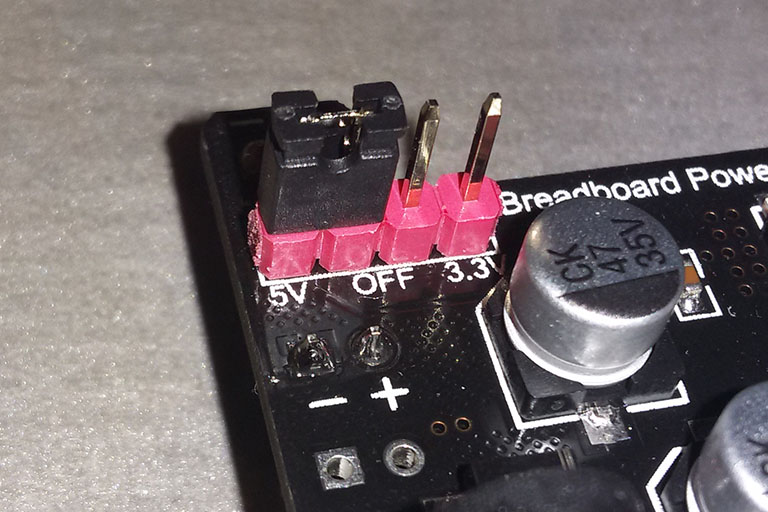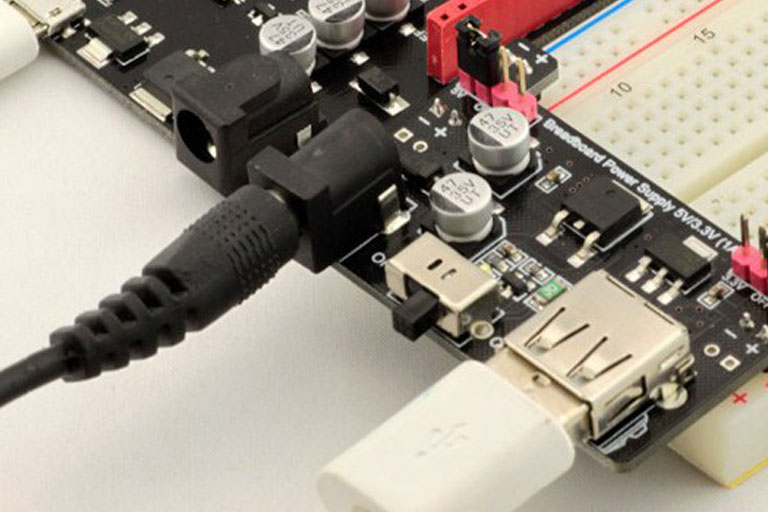Breadboard power supplies are easy-to-use, companion modules that provide a regulated voltage to the power rails of solderless breadboards.
Table of contents
Introduction to breadboard power supplies
A breadboard power supply is a small companion module that provides a regulated voltage to the power rails of a solderless breadboard. They are easy to use and can help to speed up the prototyping of microelectronic projects.
Although there might be many different makes, shapes, sizes, voltage and amperage variations, the main idea of a breadboard power supply is to supply steady power to a breadboard.
Some models, such as the RobotDyn 5V/3.3V Breadboard Power Supply (see the video above), connects directly to the power rails of a breadboard supplying Vcc and GND connections. The input of these power supplies is chosen to be able to be down-regulated to supply its intended voltage and amperage levels.
- Get the Breadboard Power Supply 5V/3.3V from Amazon.com or BangGood
- Get the Basic Arduino Uno R3 Starter Kit from Amazon.com or BangGood
- Get the Microelectronics Starter Kit from Amazon.com or BangGood
Power output
The most important aspect of breadboard power supplies is their power output settings.
Although the power output may vary depending on the model, most breadboard power supplies will have output voltage setting for 5V DC and 3.3V DC. In the image below, a jumper is used to set the desired output voltage.
Each of the two power rails can be set to have its own voltage setting. By setting the jumper to OFF, one of the two power rails can be disconnected.
Typically a voltage regulator will guarantee a supply 1A on the 5V setting and 800mA on the 3.3V setting. The power output can be confirmed using a multimeter.

Some breadboard power supplies might have more than one selectable power output. This one uses a jumper to set between 5V DC, off and 3.3V DC.
Power output for each rail can also be connected using soldering points situated directly on the board. 5V power can also be supplied to a standard 5V USB by using the onboard USB connector.
Breadboard
Most breadboard power supplies are made to fit a standard 5.5cm / 2.2″ prototype breadboard.
Power input
Power is supplied using the standard 5.5 x 2.5 mm DC barrel power connector connected to the power input socket on the side of the breadboard power supply.

Power to a breadboard power supply is supplied using the standard 5.5 x 2.5 mm DC barrel power connector. Here the on/off switch and the USB out are also seen.
Breadboard power supplies down-regulate the voltage and amperage of its power input to the indicated levels. In the video above, a 12V 1A supply was used, but a 500mA (6 Watts) power supply will probably supply enough power too.
On/off switch
An on/off switch adds an easy way to connect and disconnect power to the breadboard power supply. Power to the board will be indicated by the onboard LED.
In the case where there is no on/off switch, power can be disconnected by disconnecting the power input.
Conclusion
Although there are some variations in design and power output, most breadboard power supplies will have a voltage output of 5V/3.3V DC and will fit snugly on the standard prototype breadboard.
A 6-12 Watt power supply would suffice in supplying enough power to the board.


Some brands of these Breadboard Power Supplies are dangerous for other electronic devices on the breadboard ! The reason: they have no overcurrent protection and on overload the current switching device goes thru and the electronic on the breadboard is killed by overvoltage.
After 4 incidents in this way my attitude is: During developing new circuits its normal to have sometimes overcurrent. For the price of these power supplies I expect no folding back behavier, but a small fuse to protect the devices behind. These power supplies are not worth any cent.
Best regards
Niki